GDC 2006: Exhibit hall round-up
(San Jose, CA) - The Game Developer's Conference is more conference than tradeshow and the exhibit hall of the event isn't quite another CES or CeBit. But the showfloor revealed a few goodies and provided us with a glimpse of current and future technologies. Here is our summary with some of the more notable exhibits.
Show floor Xbox 360 kiosks

"Fight Night Round 3" is an engaging new boxing simulation that may also attract more viewers than similar games in the past. From far away, the Xbox 360 game looks like a real boxing match. Realistically rendered boxers gasp for air and reel from punches. They even hit the mat with a satisfying sounding thud. Microsoft had several Xbox 360 kiosks running the game.
3DConnexion - SpacePilot controller

3D artists running applications such as Maya or 3D Studio Max often have to switch between mouse and keyboard to use the numerous keyboard shortcuts. 3DConnexion was showing off its SpacePilot controller, which speeds up work by allowing artists to store shortcuts in 21 keys. In addition, the central knob provides directional control along with up/down control by pushing or pulling.
According to 3DConnexion, the controller can be adapted for gaming, but its primarily meant for professionals. At a street price of $499, we agree.
Logitech - G7 Laser Cordless Mouse
Stay on the Cutting Edge
Join the experts who read Tom's Hardware for the inside track on enthusiast PC tech news — and have for over 25 years. We'll send breaking news and in-depth reviews of CPUs, GPUs, AI, maker hardware and more straight to your inbox.
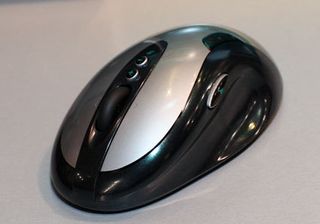
Logitech demonstrated its new G7 cordless laser mouse. The mouse is powered by rechargeable lithium-ion battery packs; a useful battery gauge is integrated on the top left-side of the chassis.
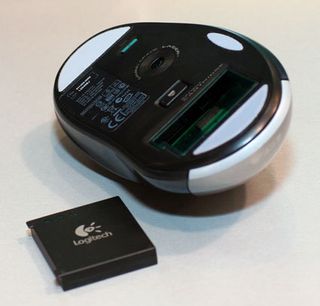
The G7 has a resolution of 2000 dpi. Users can adjust the sensitivity on-the-fly by pushing the "+" and "-" buttons just below the scroll wheel.
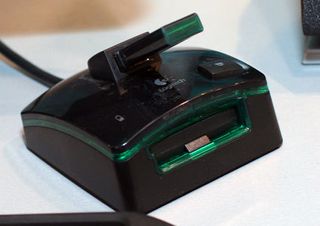
Two rechargeable lithium-ion battery packs are included, which can be charged in the wireless transmitter body. The transmitter hooks up to the computer via the USB port. The Logitech G7 mouse is currently selling for about $100.
Matrox - three monitors for your laptop or desktop

Matrox is becoming a more frequent sight a consumer tradeshows again. The company is on a roadtour with its TripleHead2Go box - a palm-sized device that connects to a desktop or laptop graphics port and powers up to three monitors. Resolutions of up to 3840 by 1024 pixels are supported.
The TripleHead2Go does not actually contain a graphics processor and merely stretches the existing desktop. It will be available next month for around $299.
Nvidia - Mobile gaming chips

Want to play some 3D games on your mobile phone? Nvidia was showing the GoForce 5500 graphics chip that will be used for upcoming PDAs and mobile phones. The chip can play back WMV, MPEG4 and H.264 videos. Plus it supports hardware encoding of MPEG4/H.264.
S3 Graphics
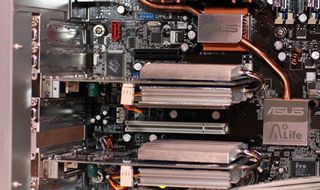
S3 Graphics had two interesting products on display. The first was their "MultiChrome" technology which uses two S27 graphics cards to render video. This setup is similar to ATI's Crossfire and Nvidia's SLI solutions. The difference is that MultiChrome uses an "open architecture" that does not depend on the chipset and company officials told us gamers can install two video cards in "any motherboard" with two PCI Express slots.

Next to the MultiChrome machine we saw a thin Fujitsu laptop running a mobile version of the S25 graphics chip. Weighing just over four pounds, S3 officials said the laptop is capable of dealing with most 3D games. The new laptop will be hitting the Asian markets first, but S3 says there is a chance it will reach American shores later this year.
GameCaster

Watching competitive gaming from the players view can be a bit boring compared to popular real-life sports like football and basketball. One of the reasons: Real-life events are often covered by professional cameramen who can follow the action from the third-person view, rather than the first-person view often used in computer games. GameCaster hopes to change all that with its GameCaster camera units.
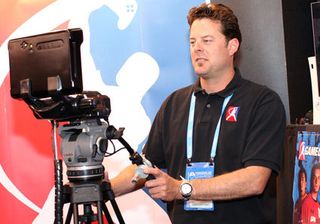
GameCaster hooks into the computer via USB 2.0 connections and adds a virtual third-person viewpoint that can be zoomed, panned and tilted like a regular camera. Manning the camera at GameCaster's booth was a professional cameraman who usually follows sports such as football, basketball and the Olympic Games. "Covering computer games is much tougher than football," he told us. He added that in-game characters are more mobile, often going straight up or zooming across the screen.
According to GameCaster, the camera units will be leased to companies for a monthly fee and a percentage of revenues.
Most Popular

